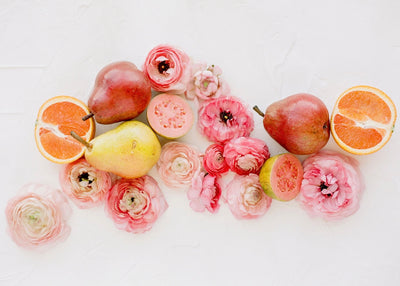Good Dogs Go Green [Tips On Being An Eco-Friendly Dog Mom]

Written By L&C Contributor Lena Samford @lenasamford
Hi there babe! I’m Lena — a fellow dog mom and friend of Lindsey’s! I showed my girls, Indi and Elaina, photos of Paris and the chiggys on the blog and they wanted to bark in (Get it? Get it?) and share our knowledge.
My expertise is how to live a sustainable lifestyle, not just for humans but for our four-legged family members too.
I dropped an extended version of this information on my podcast Hometown: Earth. Click here if you want to take a listen. But today you’re going to get the rundown with bonus content made especially for the L&C crew!
Sustainable living is aalll about living in harmony with Mother Nature. This doesn’t mean you have to give up the things you love. Instead you learn to live with a little less waste and harm; which translates to a healthier life for you and the people around you. (And let’s be honest - dogs make the best people.)
Don’t you want a long, healthy life for your companion? Ok good. I’m glad we are on the same page!
To give you a little background — I was listening to Elaina go to town on a hard nylon bone thinking, “She’s going to break a tooth!” when I realized she probably could. And I realized she was eating the pieces of the nylon that she chewed off of it. Umm, that’s not good.
That set me down a rabbit hole, googling the effects of what my girls were putting in their furry little bodies. What I uncovered was a whole world of knowledge on how to keep them safe and healthy; which consequently relates to how sustainable they are.
Our domesticated pets have a carbon footprint (or paw print) just like us! In fact, it is estimated that a medium-sized dog can have a carbon footprint twice the size of an average-sized SUV! From the food that they eat to how they play and lounge, and yes how they go number two, our companions carry a serious toll on the planet. So we are sharing the best dog and planet-friendly tips with you right here!

Bone Appetit
So let’s talk about step one — what we are feeding our pets. For most of us, our pets are like family. But while we work to improve our own health through food, we often forget to do the same for our dogs. We buy what looks the best at whatever store we favor. (I’m pointing the finger at myself here too!) What we feed our pets is one of the most important ways to be sustainable because what goes in matters — as well as what comes out. But we will get to that later.
For decades, low-grade pet food (made from things I promise you don’t want to know about) was the norm. Most of the common brands are filled with preservatives, hormones, and chemicals with filler ingredients that don’t actually benefit your dog’s health. But thankfully, now more sustainable, health options are coming out on the market for you to consider.
In simplest terms, looking for higher quality food with the least amount of artificial preservatives and chemicals is key. Avoid foods with propylene glycol, BHA, BHT, ethoxquin and low-quality fillers like corn and soy products. Search for simple meat and vegetable ingredients with a healthy source of fat. And buy organic if possible.
Organic is more expensive but it is something to consider if you’re looking for cheaper vet bills and a longer, healthier lifespan for your pet. Try finding USDA Certified Meat Products instead of “meat or bone meal” or “animal by-product meal.”
Since it’s hard to say that one food is better for your animals than another, there are sites out there like Dogfoodadvisor.com to help you figure out which is the best option for you.

Did Someone Say Treat?
All of the information I stated above applies to treats as well. For instance, even rawhide chews, which most people buy, are processed like leather products using harsh chemicals like lye, bleach and are covered in artificial flavorings. This makes them hard to digest. That was a hard lesson that my girl Indi had to learn! So you need to make sure you’re buying natural, digestible treats that are sustainably sourced.
Another option for treats and food is making the food yourself if you have the time. You could meal prep for your pet once a week using organic ingredients so you know exactly what your dog is eating. And you’ll know the food is healthy for them because it doesn’t contain chemicals and preservatives. Just be sure to talk to your veterinarian first.
Some easy treat ideas for dogs that are low calorie could include apples (without the core or seeds), carrots, broccoli, green peas, or green beans — just be sure you’re not seasoning them.
What Goes In, Must Come Out...
So like I said before, what goes in must come out. So if you’re feeding your pet foods that are high in preservatives and low in nutrients, that’s exactly what is going to come out in the form of pet waste. I know that cleaning up pet waste is the part of having a pet no one enjoys, but it is one of the most important ways to be a sustainable pet owner.
The pet waste problem is twofold. There are bacteria caused by the waste, as well as the issue of the method of disposal which is harmful to the planet. If you’re a dog owner you’re likely picking up twice a day, which is about 700 plastic bags and about 365 pounds of poo per year, per dog.
Picking up after your dog is important because that waste ultimately breaks down and goes into our local water systems, which is bad for a few different reasons. It causes excessive algae growth in streams or lakes which reduces oxygen and releases compounds that are harmful to the other animals who depend on those water sources. It also contains bacteria (we’re talking e.coli and salmonella) and parasites (which are a big risk for humans).
Then comes the method of disposal. We said for dog owners you’re throwing away an average of 700 plastic bags per dog, which is going to last centuries in landfills. But what is the best way to dispose of it? The best options I found was to check with your municipality and, if they allow it, have a separate compost method for your dog waste. Or, you can use a pet waste digester, like the Dog Dooley, which is a good choice if you have a yard because it acts as a septic tank for your dog’s waste. Both of those options are not realistic for a lot of people. So for the majority of people the most feasible option is the bag —just make sure you look for bags that are BPI Certified Biodegradable (not oxo-biodegradable).

That’s So Fetch!
Now to the part which is usually the fun part for most pet parents —the toys, beds, apparel and other supplies we get to spoil our dogs. But are we actually spoiling them if we aren’t checking what the product is made of? It’s likely we may be doing more harm than good.
A study was done by the Environmental Working Group revealing that our pets can be subjected to much higher levels of plasticizers, grease-proof chemicals and fire retardants than humans — with the main sources being coated plastic food bags, plastic toys, pet beds, veterinary medicines, pet shampoos and carpets. As you can guess, that causes A LOT of health issues for our pooches and is not good for the planet.
Chemicals in your pet shampoos and sprays are noteworthy to avoid for the health of your pet since their skin is their largest organ. The most common ones to avoid are phthalates, artificial colors, fragrances and parabens.
While we’re still talking chemicals, make sure that when you’re using flea and tick repellant that you consider non-toxic alternatives that leave organophosphates behind and get the job done just as well.
When it comes to toys, instead of going out and buying a new plastic toy for your pet, try to find an existing animal-safe item at home which may work just as well. For instance, old socks, rope, or jeans that you can make into braided rope toys.
When you’re buying new, leave the traditional tennis balls behind and look for renewable materials like wood, hemp, organic cotton or sustainably-sourced rubber. These don’t have the harmful chemicals that I just mentioned. Not so fun fact — there are no regulations on dog toy safety unless they affect humans. So look for products that are BPA and phthalate-free.
The same thing goes for sustainable pet beds and apparel. Try to make sure you’re using renewable materials. Some of these natural products can stand up to even the roughest of players. (Like my Elaina!)
Happiness Is A Long Walk With Your Dog
Consider walking Fido more so they might not even need the toy to burn off excess energy! But instead of driving to a dog park, try searching for one nearby and get that extra bit of exercise in. This will help reduce your carbon footprint from driving, it’ll save you gas and money, and get an extra workout in for you!
Check your local businesses to see who allows dogs. Maybe you can walk them to the store with you next time you want to browse! Chain stores like Marshalls, Lowes, Barnes and Noble’s, and Home Depot allow pets too!

Oh, This New Thing? I’m Over It!
My dogs LOVE when they get new toys. But then the magic quickly fades (or they rip it to pieces) and they’re over it. Don’t throw them away! I hang on to my girls’ toys and usually, when I bring them back out a few months later it’s like brand new!
If you want to get rid of any of these pet toys (or supplies) donate them so it doesn’t go into a landfill. Most local animal shelters accept any donations including old pet toys, beds, water bowls, brushes and grooming tools, and more. Just be sure you clean the items before you donate them. If your local shelter won’t take it, usually another non-for-profit will.
Adopt Don’t Shop
Whether you’re looking now or considering another down the road, there are enough animals in shelters that we should be adopting. The ASPCA says that 6.5 million companion animals enter U.S. animal shelters nationwide every year; with approximately 1.5 million of them being euthanized every year. If you’re looking for a specific dog, there are breed-specific rescues for almost every type of dog. As a matter of fact, it is estimated that 25% of shelter dogs are purebred. Both of my girls are adopted and we get questions all of the time if they’re purebred!
You also want to make sure that whatever animal you have, you have them spayed and neutered. This reduces the number of unwanted pets and actually increases their lifespan. It also positively impacts their health because it makes them less susceptible to infection and disease.
I hope this was helpful! Love is a four-legged word. So let’s show our pets we love them by taking care of them and the planet they live on!
XO’s and Pawprints,
Lena, Indi and Elaina

![Is The Side Hustle Culture Low Key Toxic? [6 Benefits of Slow Grow]](http://lindseyandcoco.com/cdn/shop/articles/IMG_1332_400x.jpeg?v=1599433126)
![2020 Vision [How To Plan For The Future Without Anxiety]](http://lindseyandcoco.com/cdn/shop/articles/IMG_3644_400x.jpg?v=1730923501)

![The Not So Simple Cruelty-Free Products Maze. [Your Quick Guide To Cruelty-Free Labels]](http://lindseyandcoco.com/cdn/shop/articles/69347F2A-04F5-469D-A1DF-7BF5E0F7FD85_400x.jpg?v=1622375899)


![The Best At Home Strength Workouts + Pilates Home Gym Accessories [Plus Our Fave Peloton Instructors + Fitness Focused Dog Moms From Instagram]](http://lindseyandcoco.com/cdn/shop/articles/2A2A273A-D1D1-4C50-B064-78941FDABE3F_f84ce598-8727-47de-8964-3719d29f97da_400x.jpg?v=1738628055)
